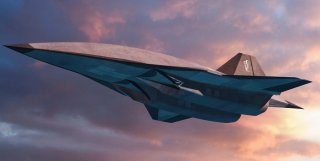Did Hypersonic Missiles Kill the SR-72 Spy Plane in the Womb?
Since 2018 there has been no further news about the Lockheed Martin demonstrator.
Here's What You Need to Remember: It’s also possible that the project may be continuing under a “black budget,” due to how secret its predecessor was. As the SR-72 brings a different kind of capability, the military may have chosen only to reveal hypersonic projects that are on par with what other nations are doing with hypersonics to preserve the secrecy of other hypersonic projects and not reveal their entire hand.
In early 2018, two hypersonic UAV demonstrators revealed by Lockheed Martin and Boeing raised eyes in many media outlets. Said to be follow-ups to the famed SR-71 Blackbird, which was known for breaking speed and altitude records, the Lockheed Martin demonstrator was dubbed “SR-72” or “Son of Blackbird” by many outlets. The role of the craft was given as reconnaissance, but it was also speculated that the craft could perform strike missions.
But since then there has been no further news about the Lockheed Martin demonstrator. Why? A look at it may reveal how drastically thinking about hypersonics has changed in the last two years.
A possible reason for the quiet “shelving” of the SR-72 is that Russia’s March 2018 test of the Kinzhal hypersonic missile caused the United States to refocus the priorities of its hypersonic development. Hypersonic became a buzzword of sorts, with President Donald Trump mentioning them by name during multiple state addresses.
As a result, many hypersonic missile projects from various branches were brought into the spotlight in 2018 and 2019. The U.S. Army and Navy’s premier project is the Common Hypersonic Glide Body (C-HGB) made by Dynetics Technical Solutions and integrated by Lockheed Martin. This is expected to become the Long Range Hypersonic Weapon (LRHW) for the Army, and Conventional Prompt Strike (CPS) for the Navy. The U.S. Air Force on the other hand, had two hypersonic missile projects in development by Lockheed Martin, the Hypersonic Conventional Strike Weapon (HCSW) and the Air-launched Rapid Response Weapon (ARRW), one of which was cancelled in early 2020. The LRHW, CPS, and ARRW are the primary hypersonic projects of note in the Department of Defense’s FY2021 Budget Request Overview.
All of these projects are notable as they are very offensively focused missiles, as opposed to the SR-72 which looked to leverage hypersonic technology more for the intelligence role. They also are far simpler than the SR-72, only needing to go fast to a specific target following an initial launch or boost, without aerodynamic considerations for landing and takeoff.
But Lockheed Martin’s full development of the Air Force’s hypersonic weapons may give it an edge in future development of the SR-72. Lessons learned from making the ARRW could be applicable to the SR-72, and it may be easier to sell the Air Force on the SR-72 if the ARRW program is successful.
It’s also possible that the project may be continuing under a “black budget,” due to how secret its predecessor was. As the SR-72 brings a different kind of capability, the military may have chosen only to reveal hypersonic projects that are on par with what other nations are doing with hypersonics to preserve the secrecy of other hypersonic projects and not reveal their entire hand. If so, the lack of news on the SR-72 is probably deliberate, and people will not know what has become of the project in the near future.
Charlie Gao studied political and computer science at Grinnell College and is a frequent commentator on defense and national-security issues. This first appeared earlier and is being reposted due to reader interest.
Image: Creative Commons.

